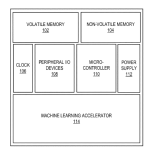looked at Quadric a few months ago. From recall, they use ALUs.
Big announcement from one of our AI IP partners! | Douglas Fairbairn
Big announcement from one of our AI IP partners!www.linkedin.com
View attachment 20966
Looks to be CNN, not SNN. Not us?
Also, nobody from Brainchip has "liked" it yet.
https://worldwide.espacenet.com/pat...pa = "quadric" AND nftxt = "machine learning"
US10474398B2 Machine perception and dense algorithm integrated circuit
[0035] An array core 110 preferably functions as a data or signal processing node (e.g., a small microprocessor) or processing circuit and preferably, includes a register file 112 having a large data storage capacity (e.g., 4 kilobyte (KB) or greater, etc.) and an arithmetic logic unit (ALU) 118 or any suitable digital electronic circuit that performs arithmetic and bitwise operations on integer binary numbers. In a preferred embodiment, the register file 112 of an array core 110 may be the only memory element that the processing circuits of an array core no may have direct access to. An array core no may have indirect access to memory outside of the array core and/or the integrated circuit array 105 (i.e., core mesh) defined by the plurality of border cores 120 and the plurality of array cores 110 .
[0039] An array core 110 may, additionally or alternatively, include a plurality of multiplier (multiply) accumulators (MACs) 114 or any suitable logic devices or digital circuits that may be capable of performing multiply and summation functions.
[0040] Accordingly, each of the plurality of MACs 114 positioned within an array core 110 may function to have direct communication capabilities with neighboring cores (e.g., array cores, border cores, etc.) within the integrated circuit 100 . The plurality of MACs 114 may additionally function to execute computations using data (e.g., operands) sourced from the large register file 112 of an array core no. However, the plurality of MACs 114 preferably function to source data for executing computations from one or more of their respective neighboring core(s) and/or a weights or coefficients (constants) bus 116 that functions to transfer coefficient or weight inputs of one or more algorithms (including machine learning algorithms) from one or more memory elements (e.g., main memory 160 or the like) or one or more input sources.
[0049] The dispatcher 130 preferably includes processing circuitry (e.g., microprocessor or the like) that function to create instructions that include scheduled computations or executions to be performed by various circuits and/or components (e.g., array core computations) of the integrated circuit 100 and further, create instructions that enable a control a flow of input data through the integrated circuit 100 . In some embodiments, the dispatcher 130 may function to execute part of the instructions and load another part of the instructions into the integrated circuit array 105 . In general, the dispatcher 130 may function as a primary controller of the integrated circuit 100 that controls and manages access to or a flow (movement) of data from memory to the one or more other storage and/or processing circuits of the integrated circuit 100 (and vice versa). Additionally, the dispatcher 130 may function control execution operations of the various sub-controllers (e.g., periphery controllers, etc.) and the plurality of array cores no.
Pretty ugly really ...









